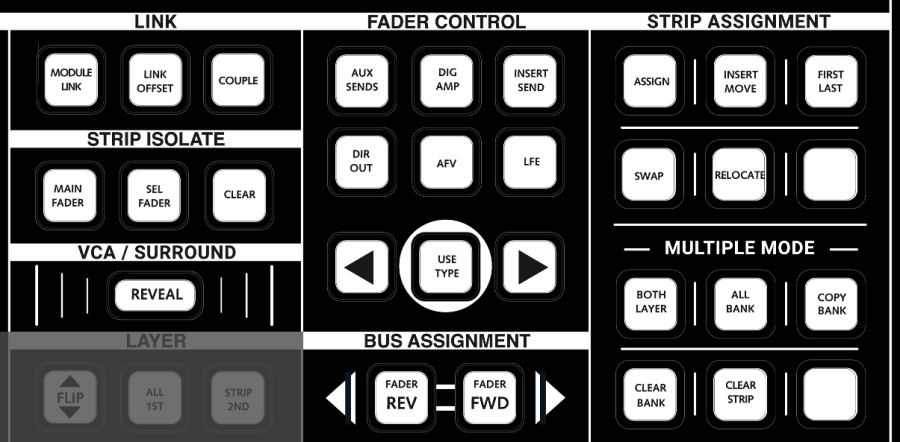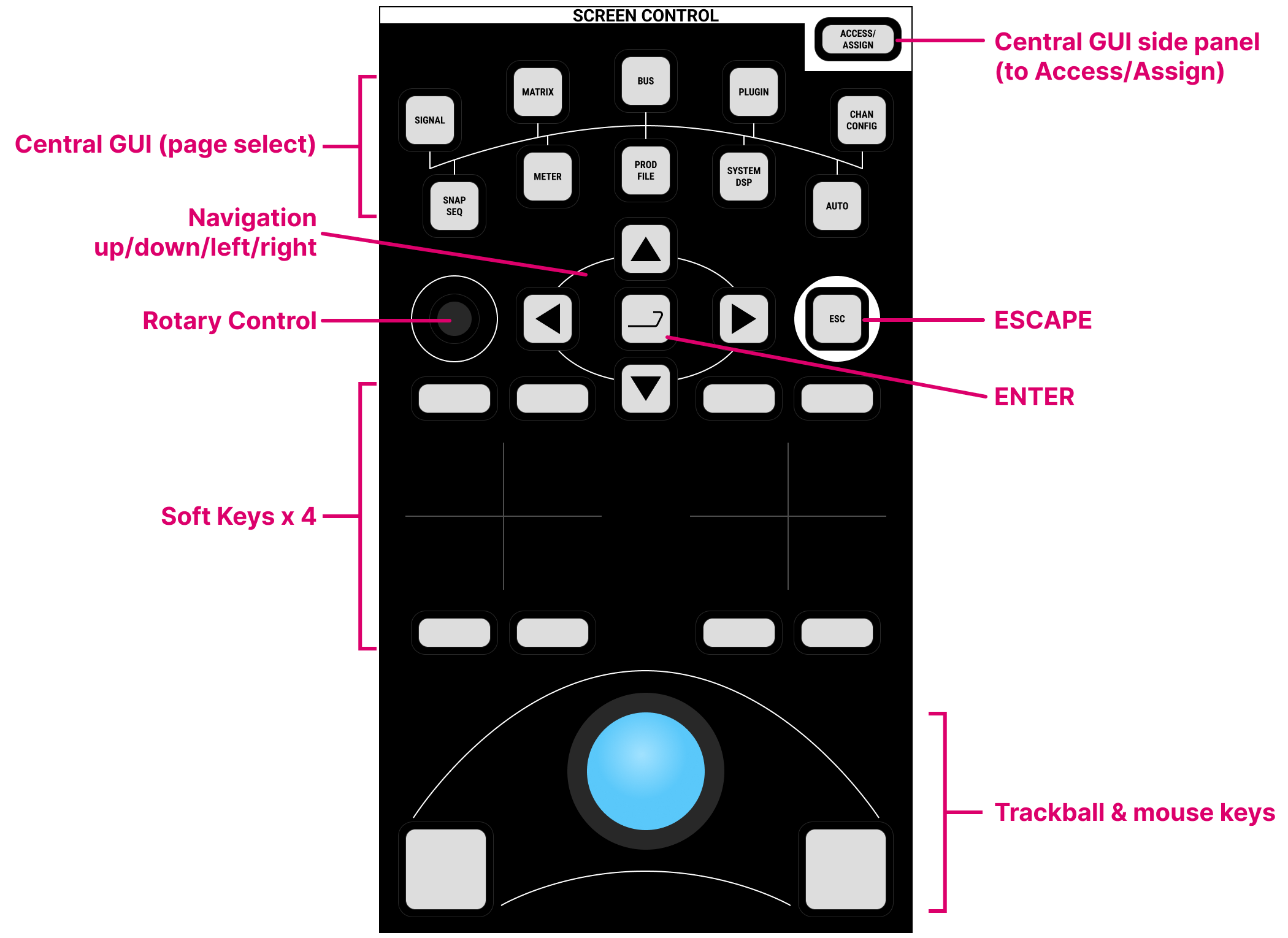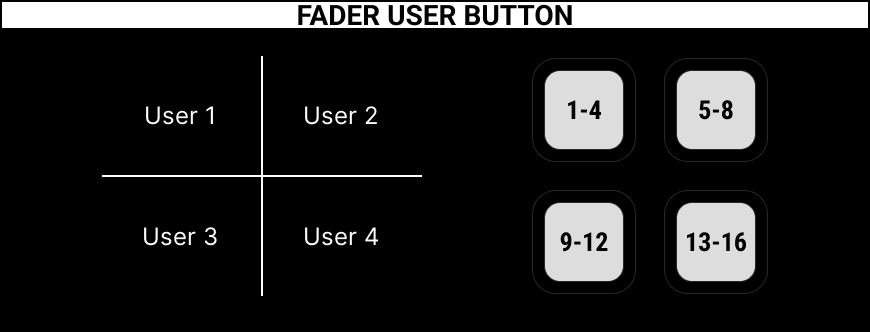mc²56 - Master Controls
The centre section provides master controls and navigation for the Central GUI.
This topic describes each of the control areas, from top to bottom and left to right.

TALKBACK
This area provides four central user buttons (ideal for global talkback functions). The user buttons are programmed from the Custom Functions display. Note that they can be assigned to any central user button function, not only talkback switching.
A talkback mic can be connected to the female XLR connector (to the left of the Lawo logo). This is wired directly to the TB connector on the console's rear panel. From here, it can be connected to the console's local MIC IN 16 (on the rear panel). The input must then be defined as the talkback source in the relevant Custom Functions.
PRODUCTION
The UPDATE button saves the current console settings into the active production. Note that the button overwrites (updates) the active production. If new snapshots have been saved, then the button flashes as a reminder to save.
Above the button is a USB port. This can be used to connect a memory stick to import or export productions and other user data.
MONITORING
The CRM 1 and CRM 2 rotary controls adjust the level of the control room monitoring outputs. The physical controls work in conjunction with the Central GUI (as described later).
FC PRESETS
The FC PRESETs assign parameters onto the fader strip Free Controls. They temporarily override the default assignments, and are a great way to access a parameter globally across the console.
The upper row of buttons are pre-defined at the factory (PAN, LVL/DLY, etc.), while the lower row can stored user-defined parameter combinations. In both cases, the PAGE button can be used to access two pages of functions.
To store a user-defined preset:
- Select a fader strip with the Free Control parameters you wish to store.
- Then press and hold one of the USER # preset buttons until it flashes - this stores the selected channel's Free Control assignments.
To recall a preset, press the USER # preset button quickly - the stored assignment is recalled globally across the console.
When all FC PRESET buttons are deselected (off), the fader strip Free Controls return to their default assignments.

LINK
The MODULE LINK and LINK OFFSET buttons are used to create and manage link groups. The COUPLE button can be used to create a couple.
STRIP ISOLATE
The STRIP ISOLATE options can be used to isolate fader strips from bank switching: either all main fader strips (in the centre section), or specific fader strips (in any bay).
- Turn on MAIN FADER to isolate all main fader strips.
- Or, press SEL FADER and then select the strips you wish to isolate (by pressing their fader SEL buttons: red = selected).
- To clear all isolations, press CLEAR.
VCA / SURROUND
The REVEAL button reveals the channels assigned to a VCA or bus master so that you can apply offsets. The function can be used to reveal a VCA, Surround VCA, Group, Aux or Sum.
First, select the VCA or bus master by pressing its fader SEL button. Then press REVEAL - the channels assigned to the VCA or bus appear in the global reveal position (defined using the "Console → Reveal" options in the System Settings display).
FADER CONTROL
The FADER CONTROL options temporarily assign another level parameter onto the console's faders.
For example, press AUX SENDS to assign an aux send - the fader labels across the console show the parameter name (e.g. AUX 1), and flash to warn you that you are now controlling something other than the main channel level! You can now use the arrow buttons to scroll through the available aux sends.
Alternatively, touch an aux send control (on the Central Control Section) and then press USE TYPE - this switches the faders directly to say Aux Send 28 without scrolling.
The following level parameters can be controlled in this manner: AUX SENDS (send levels); DIG AMP (digital amplifier gain); INSERT SEND (insert send level); DIR OUT (direct output level); AFV (audio follow video On level); LFE (Subwoofer level).
BUS ASSIGNMENT
The FADER REVERSE and FADER FORWARD buttons are used to make bus assignments either to or from the channel in access. For example, to assign several input channels to a sum:
- Select the SUM, either by pressing its fader SEL button or using the Access/Assign panel.
- Then press FADER REV - the fader SEL buttons across the console show the current assignments: red = assigned; flashing green = unassigned.
- Now press the fader SEL buttons to change the assignments.
The same method can be used to assign channels to a group, aux or VCA. FADER FWD works in a similar manner but this time select the channel you wish to assign from (e.g. an INP channel).
STRIP ASSIGNMENT
The STRIP ASSIGNMENT area is used to assign channels to the fader strips. From here you can assign a single or range of channels; insert, re-locate or swap channels; and make assignments across multiple banks and layers.
For more information, see mc²56 - Strip Assignment.
LAYER & BANK Switching

The BANK 1 to 6 buttons switch the fader strips, globally, between banks. One button is always lit; this is the active bank. Six banks are available.
Within each bank, you can press LAYER FLIP to invert the layers; ALL 1ST to reset all fader strips to layer 1; and STRIP 2ND to reset all channel fader strips to layer 2.
The MAIN BAY button can be used with both BANK and LAYER switching. When it is turned on, the bank/layer selections affect only the main faders. When it is turned off, the bank/layer selections affect all fader strips across the console, except for those in an isolated bay (ISO BAY on) or with an ISO state active (under STRIP ISOLATE).
CENTRAL USER BUTTON
All user buttons are programmed from the Custom Functions display and are stored at a system level. This means that any changes will affect all users.
LABEL

The LABEL buttons change what is shown in the "label" fields on the fader strips and GUI. From here, you can choose which text labels are in view, and whether LiveView images are enabled.
- CHANNEL NAME = the system name of the channel (e.g. INP 1). This is system-defined and cannot be edited.
- USER LABEL = the user label given to the channel (e.g. Guest).
- INHERIT SOURCE = the user label given to the source connected to the channel (e.g. Mic 1).
If the IMAGE button is enabled, then the 'Signal Thumbnails' assigned to the channel or source are displayed instead of the text labels.
For more information, see mc²56 - User Labels.
FADER USER BUTTON
This panel switches the fader strip user buttons, globally, between their four pages of functions. Press the 1-4, 5-8, 9-12 or 13-16 buttons to select a page. The current functions are shown on the FADER USER BUTTON panel (beside the page buttons).
SCREEN CONTROL
The SCREEN CONTROL panel works in conjunction with the Central GUI. It can be used for page selection and navigation.

The following operations are possible:
- ACCESS/ASSIGN - press this button to switch the Central GUI side panel between MONITORING and ACCESS/ASSIGN. The side panel pages are described here.
- Display Selection - press a button (e.g. BUS) to change the Central GUI display. In most cases, the button provides access more than one page, so keep pressing to cycle through all available pages.
- Rotary Control - this control can be used to adjust a value (once a parameter field is selected) or scroll up and down (when working in a list).
- Navigation Keys - the up/down and left/right arrow keys change which part of the Central GUI is in focus. They can be used in conjunction with the rotary control to make selections or adjust parameter values.
- ENTER Key - press this key to confirm an operation.
- ESC Key - press escape to cancel out of an operation.
- Soft Keys - the soft keys are labelled by the displays and provide quick access to context-dependent operations. Their functions vary depending on the selected display and area in focus. For example, with the Snapshot List in focus, you can perform snapshot operations: LOAD, SAVE, etc.
- Trackball & Mouse Keys - as an alternative to the touch-screen, you can use the trackball and mouse keys to make selections: left-click to make a selection or enable/disable on-screen buttons; right-click to view the context menu options.
Note that all of the soft key functions are duplicated on-screen, either as a dedicated button or context menu (right-click) option.
The operation of the Central GUI is described in the next topic.

